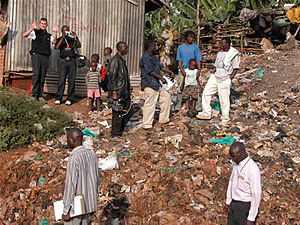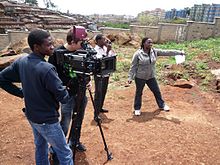- Cinema of Kenya
-
Cinema of
Kenya
List of Kenyan films Kenya Film Commission Hot Sun Foundation Lola Kenya Children's Screen The cinema of Kenya refers to the film industry of Kenya. Although a very small industry in western comparison, Kenya has produced or been a location for film since the early 1950s when Men Against the Sun was filmed in 1952. Although, in Hollywood, jungle epics that were set in the country were shot in Hollywood as early as the 1940s.
Contents
Kenyan cinema
Rather than featured films with fictional content, Kenya has mostly produced documentary films often relating the conditions of the people and poverty in the main cities of Kenya. Since 2000 feature films on DV technology production have increased in the country. They include Dangerous Affair, Project Daddy and Money & the Cross by Njeri Karago, Babu's Babies by Christine Bala, Naliaka is going by Albert Wandago, The price of a Daughter and Behind closed doors by Jane Murago-Munene, The Green Card by Brutus Sirucha, Malooned by Bob Nyanja, All Girls Together by Cajetan Boy, Help by Robert Bresson and From a Whisper by Wanuri Kahiu. Numerous short fictions are also on the increase such as Ras Star by Wanuri Kahiu, Subira by Kenya-based Indian film director Ravneet Sippy Chadha, Life in D Major by Angelo Kinyua, and Extracts of Me by William Owusu. Other low-budget independent filmmakers using digital technology to shoot their films and sell them locally on DVD and VCD format have spawned the Riverwood Industry. Though it originally takes it name from River-road, the busy street where music tapes and electronics are sold, Riverwood is fast capturing the attention of the mainstream TV stations and pan-African broadcasters. Mburu Kimani's The Race earned an award at the inaugural Kalasha Awards (Kenya's TV and Film Awards) for Best Riverwood Film.[1] Other films in this genre include Simiyu Barasa's Toto Millionaire (2007), and numerous other vernacular films like Kihenjo and Machangi
Films such as 2006's I Want to Be a Pilot relates an emotional tale of a young boy living in poverty in Nairobi who has dreams and aspirations of becoming an airline pilot and being set free from his life of hardship.
Film such as 2010's Togetherness Supreme a fictional feature flm by Nathan Collett have received national and international attention [2] for revealing some of issues affecting Kenyan society. Togetherness Supreme tells the story of Kamau, an artist, who uses his talent to promote change in Kibera. Togetherness Supreme tells a story of love, conflict, and ultimately, of reconciliation.[3]
Kibera Kid directed by Kenya-based director Nathan Collett is a short twelve minute film which covers themes of crime and poverty in the slums of Kibera, Nairobi and also morality as the young protagonist must make a choice between living with a gang of thieves or living a life free of crime. The story is fictional but the circumstances and reality depicted are not. The film received seven international awards and received attention at various film festivals worldwide including the Berlin Film Festival and it was accoladed with a Student EMMY in Hollywood. It has been profiled by BBC, Reuters, Al Jazeera English and many others.[4] Other than this directors such as Collett have shot other short films such as The Oath, a 2005 historical short set in the 1950s during the Mau Mau uprising under the British colonialism in Kenya. It portrays the struggle between two brothers on opposite sides fo the conflict. Many of the actors used in the film were descents of Mau Mau fighters.
Whilst the number of films shot in the country has increased in recent years, the country lacks the financial resources and investment needed to produce larger scale feature films and employ professional actors. It is far behind other African film producers such as South Africa and Egypt who have been producing feature films since the early twentieth century.
The Kenyan government has made a conscious effort to develop Kenyan cinema as an industry, and in 2005 the government helped establish the Kenya Film Commission (KFC) which came into operation in mid-2006. The Kenya Film Commission aims to promote the industry not only within the country but to raise international awareness and interest from potential investors. The commission falls under the Ministry of Information and Communication that is headed by Samuel Poghisio. It supports the Kenyan film industry by providing facilities for screenings and filming and organising various workshops to educate local film-makers seeking to enter film production. It is also responsible for advising on licensing and immigration; as well as facilitate the filming process for film makers. The Commission is also establishing a database that will list film directors, producers, agents, local talent, stakeholders and service providers to raise the profile of the Kenyan film industry.[5][6]
In Nairobi the Hot Sun Foundation was established to help train and expose the talents of young people living in the areas of poverty and educate them in filmmaking, acting, script writing, camerawork. The foundation was responsible for producing films such as Kibera Kid.
 Aspiring Kenyan actors outside the Hot Sun Foundation offices in Kibera, Nairobi
Aspiring Kenyan actors outside the Hot Sun Foundation offices in Kibera, Nairobi
Films
Main article: List of Kenyan filmsFestivals
The annual Lola Kenya Screen (also known as Lola Kenya Children's Screen) film festival was established by creative and cultural entrepreneur, arts and culture journalist and creative writer Ogova Ondego in October 2005. Deriving its name from a Bantu language word meaning watch or see films in Kenya, the first edition of the festival was held in Nairobi between August 7 and August 12, 2006. The film festival which is also a production workshop and audiovisual media market, focuses on films by, for and with children and youth where children are given the opportunity to participate in the film selection, programme presentation, film jury, and in the making of short films. Following the first event in 2006, Films by Children for Children, the first nine-short animation made won the Grand Prize at the 5th World Summit on Media for Children/1st Kids for Kids Africa festival, and went on to be shown in countries such as Germany, Poland, Finland, Kenya, Australia, China, Denmark, and Brazil and other African countries such as South Africa, Rwanda, Tanzania, Uganda, Congo-Kinshasa and Senegal.[7] The second production, a three-film and three-song compilation titled African Folk Tales Animated, has been shown in all the continents including Oceania and has picked three awards—Most Creative Project, Special Jury Prize, Africa Grand Prize—in Africa and Europe. The third production, Africa-i-Motion, was made in 2008 and is currently on the children and youth film circuit.[7] The festival gives aspiring children the opportunity to collaborate with international partners and to also educate them in film production, screenplay writing, cinematography, and in the art department and sound production. Eastern Africa’s premier audiovisual media platform for children and youth, Lola Kenya Screen has between August 2006 and August 2008 showcased more than 1200 films from 71 nations representing all the six continents in various genres, formats and lengths. Additionally, Lola Kenya Screen has helped add 31 child filmmakers, 14 journalists, 13 film judges, 7 MCs, 15 producers of television drama for children and youth and 6 producers of documentary films for children and youth to eastern Africa’s creative and cultural spectrum.[7] The 3rd Lola Kenya Screen (August 11–16, 2008), attracted participation from Kenya, Uganda, Tanzania, and Zimbabwe, with all participants coming in to watch the wide variety of films from 56 nations and to be equipped with skills for making films, appreciating and judging audiovisual media production, presenting programmes and filing daily reports on the festival. Lola Kenya Screen was conceived as a movement that uses appropriate and available technologies to deliver audiovisual media content that complements, enhances, entertains and promotes learning among children and youth in the promotion of literacy, gender equity, independent thought, human rights, environmental responsibility and global health. Through her programmes, Lola Kenya Screen explores, identifies and nurtures creative talent among children and youth in areas such as journalism, film-making, arts appraisal and appreciation, and organisation and presentation of cultural and creative events. This is aimed at equipping children and youth with the skills to understand, appreciate, and create quality audiovisual productions in particular and arts in general. While the Festival Press is aimed at uplifting the standards of creative and cultural journalism in eastern Africa, the Production Workshop empowers children and youth to make at least five quality, low-budget, moving images per year. Programme Presentation, as the title suggest, empowers children and youth to organise and present events and programmes. Such children are usually in charge of the programme during the six days of the festival. The Film Jury, on the other hand, seeks to inculcate in participants skills with which to critically appreciate and appraise creativity in general and film in particular. The jury members watch and award films in competition. The official Lola Kenya Screen Jury consists only of children and youth. Out of the recognition that unless adults are sensitised into creating for and with children, the aim of putting children and youth on the public agenda could become a cropper, Lola Kenya Screen 2008 also worked with practising filmmakers in the production of documentaries for children and youth.[7] The 5th Lola Kenya Screen is scheduled for August 9–14, 2010 while the 4th edition ran in Nairobi, Kenya, August 10–15, 2009.
Films shot in Kenya
 Kibera Kid film production set on the slums in Kibera, Nairobi in 2006
Kibera Kid film production set on the slums in Kibera, Nairobi in 2006
The film Maasai: The Rain Warriors a cinematic epic was shot entirely in Kenya but cast a number of local Maasai warriors who spoke Maa dialogue in the arthouse film. The films relates the story of a group of young Maasai warriors, Lomotoon and Merono sent on a mission to travel through the entirety of Kenya on foot, hunting a mythical lion responsible for bringing about a major drought, and by doing so bringing back the rain. The film brought the rural Kenyan landscape to the silver screen and innovatively incorporated traditional Maasai song with a symphony orchestra. It was developed in partnership with the Maasai community, and actual tradition and legends were used as a basis for the story and used tribesmen from the Loita Hills area with no former acting experience.[8] The film Togetherness Supreme was shot in 2009 - 2010 entirely in collaboration with the youth of Kibera. It is a story based on the events of the 2007 disputed Presidential election in Kenya. It is the story of Kamau, an artist, who thirsts for change. He uses his art to bring about change, but is soon caught up in the events leading to the post election violence of 2007/8.[9]
The 1985 film, Out of Africa starring Meryl Streep and Robert Redford was shot in Kenya and revealed Kenya’s colonial history in romantic drama film. It retold the story of Danish author’s Karen Blixen’s love affair with Kenya and Hunter Denys Finch Hatton in particular. In 1999 the Canadian produced film was shot in Kenya, To Walk with Lions .
References
- ^ "Kalasha 2009: List of Winners". http://www.kalashaawards.co.ke/winners.php. Retrieved 2009-10-22.[dead link]
- ^ [1], PRI The World, August 4, 2010]
- ^ [2], The Standard (Kenya), August 7, 2010]
- ^ Kenya's Kibera kid savours stardom, BBC News, August 20, 2007]
- ^ Filmingkenya.com
- ^ ArtMatters.Info
- ^ a b c d "Official Website, Lola Kenya Children's Screen". http://www.lolakenyascreen.org. Retrieved 2009-10-22.
- ^ MagicalKenya.com, Retrieved January 24, 2008
- ^ PRI The World Retrieved August 4th 2010
External links
- Kibera Kid official site
- News report on Kibera Kid on Youtube
- Kenya Film Commission
- Film licensing in Kenya
Categories:
Wikimedia Foundation. 2010.

